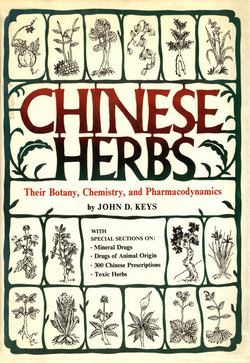Читать книгу Chinese Herbs - John D. Keys - Страница 8
На сайте Литреса книга снята с продажи.
PREFACE
ОглавлениеI CAN RECALL strolling as a child down the streets of San Francisco's Chinatown and passing by at least one herb shop in every block. They always did intrigue me, especially when I would pause before an open door and inhale the alluring smells of odoriferous woods and spices which drifted from the dim interior. Almost always an ancient Chinese, wearing a pair of immense spectacles, would be peeping out over the half-curtains in the window, and I must confess he struck me as looking rather sinister.
The window itself would be arranged with small porcelain saucers, each containing a small mound of some herb or another. There were chips of various woods, shriveled rootlets, bunches of frizzly grasses that looked like miniature tumbleweeds, rodents stretched and dried on small wooden frames, and delicate seeds. Several tall apothecary jars, almost opaque with the accumulation of years of dust, contained lengths of viper steeped in who knew what.
Small boxes covered with Chinese characters and wrapped in cellophane were arranged here and there, all of them bearing the words, "Made in Hong Kong." These were obviously modern manufactured pills which utilized the traditional medicaments of the Chinese pharmacopoeia.
After a while I became a little bolder, and would step into the doorway of one of these shops, adjusting my eyes to the darkness within. Against the wall would be a massive, ornate counter, running the length of the store. The wall itself contained row upon row of tiny drawers, each filled with a certain dried herb or other medicine. These drawers possessed no labels or other identifying marks, yet the Chinese druggists could at a second's notice locate the desired item. Sometimes they had to use a ladder, for the drawers went up to the ceiling, and back into the shop as far as one could see.
On the counter stood a scale-beam for weighing out the herbs and other medicines. Beside the scale lay a pile of rectangular pieces of paper, in which the medicines were wrapped. The druggist, following the instructions of a written prescription, would first grind the dried herbs to a powder in an earthenware mortar. Lastly, the deft fingers of the clerk would slip over the black teakwood beads of the abacus which lay at the front of the counter, to determine the amount due.
Against the other wall stood a row of high-backed, rather elegant carved chairs which were mounted on a low platform. Here the customers would sit and chat as they waited for their prescriptions. It was a symbol of prosperity to be seen leisurely passing one's time in the herb shop, for the Chinese take medicaments not only to cure illness, but also as a preventative and general tonic. And many of these wonder drugs were not cheap.
And thus began an overwhelming desire on my part to learn more about Chinese herbs, a subject so little understood by the Western world. Was the interest primarily botanical or medical? At that time I could not answer this question, but whatever inherent drive launched me on what was to become a very extensive study indeed, I immediately took the first logical and necessary step, namely the study of the Chinese language.
After several years of linguistic preparation, I undertook the translation of Chinese pharmaceutical works. Until recently, analyses in the English language of Chinese materia medica have been the result of translations from the ancient and traditional native works. Because of the vagueness of expressions and terms used by the Chinese authors, and their inclination to the marvellous, these existing translations left much to be desired, from the scientific viewpoint. My goal was the writing of something more concrete.
True, most of traditional Chinese medicine is based solely on superstition and fancy. The Chinese are much addicted to the doctrine of signatures, which is based on the belief that an external mark or character on a plant indicates its suitableness to cure particular diseases. Thus they employ a decoction of the thorns of Gleditschia or Zizyphus to accelerate the bursting of abscesses. The yellow bark of Berberis is used for jaundice. Emmenagogue properties are ascribed to the red root of Rubia cordifolia. And the well-known ginseng, whose branching root resembles the human figure, appears to be a panacea for nearly all ills.
On the other hand, Western medical science continues to discover important constituents in botanicals employed in the so-called "folk" medicines of various countries. As far as the folk medicine of China is concerned, the difficult and ambiguous language barrier has kept this area from being extensively studied. Perhaps the Japanese have made the greatest headway in this respect.
I needed to find a way to relate the many age-old plant remedies of China to today's scientific procedures, in the hope that I might open the door to further study by those more specifically qualified in the field of pharmacology. I was finally fortunate enough to locate several recent works in Chinese on the subject, recent enough to include a sufficient content of modern chemical analysis and botanical identification, together with traditional therapeutic usage as related to Occidental medical terminology. My work had just begun.
The preparation of this book, which has occupied my interest for the past twenty years, has taken me by necessity through the studies of not only the Chinese language, but also of Japanese and French, as well as the subjects of botany, chemistry, and medical science. It has been an exhausting labor of love, and vet I feel the surface has been merely scratched. The greatest feeling of accomplishment shall come only when I determine that my efforts, purely those of a layman in all the subjects above mentioned, have been of actual assistance to more legitimate research.
JOHN D. KEYS
